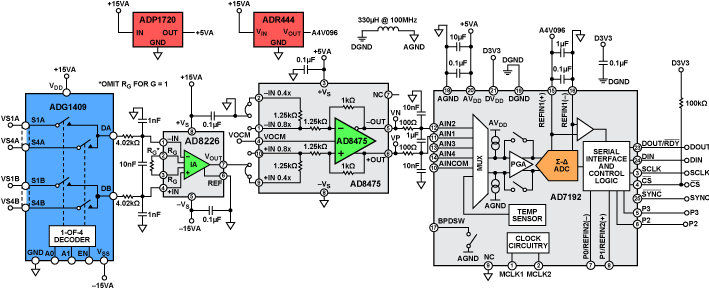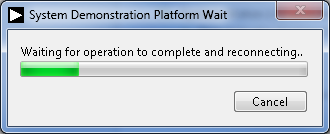CN-0251 Software User Guide
Overview
CN-0251 is a flexible signal conditioning circuit for processing signals of wide dynamic range, varying from several mV p-p to 20 V p-p. The circuit provides the necessary conditioning and level shifting and achieves the dynamic range using the internal programmable gain amplifier (PGA) of the high resolution analog-to-digital converter (ADC).
A ±10 V full-scale signal is very typical in process control and industrial automation applications; however, in some situations, the signal can be as small as several mV. Attenuation and level shifting is necessary to process a ±10 V signal with modern low voltage ADCs. However, amplification is needed for small signals
to make use of the dynamic range of the ADC. Therefore, a circuit with a programmable gain function is desirable when the input signal varies over a wide range.
In addition, small signals may have large common-mode voltage swings; therefore, high common-mode rejection (CMR) is required. In some applications, where the source impedance is large, high
impedance is also necessary for the analog front-end input circuit.
This user guide will discuss how to use the evaluation software to collect data from the EVAL-CN0251-SDPZ Evaluation Board (CN-0251 Board)

Required Equipment
General Setup
-
The +6V Power Supply powers the
EVAL-CN0251-SDPZ (CN-0251 Board) via the screw terminals at
J3.
The ±15V Dual Power supply powers the
EVAL-CN0251-SDPZ (CN-0251 Board) via the screw terminals at
J4.
The
EVAL-SDP-CB1Z (SDP-B Board) connects to the PC via the
USB Type A to
USB Mini-B cable.
The
ADALM2000 connects to the PC via the
USB Type-A to
USB Micro-B cable.
-
Connecting the Hardware
Ensure the jumpers are populated on the
EVAL-CN0251-SDPZ (CN-0251 Board) as depicted in the figure below.
-
Connect the +6V Power Supply to the screw terminal at J3.
Connect the ±15V Power Supply to the screw terminal at J4.
Connect the SDP-B Board to the CN-0251 Board

Getting Started with ADALM2000 and Scopy
Use the
USB Type-A to
USB Micro-B cable to connect the
ADALM2000 to the PC. A detailed guide on how to start ADALM2000 and install
Scopy can be found
here.
Upon connecting the ADALM2000 to Scopy, load the project file named
SigGen.ini then click on the
Signal Generator tab on the left pane.

Click the
Run button.

Using the Evaluation Software
Software Control and Indicator Descriptions

Connect/Reconnect Button
When this button is pressed, the SDP-B Board makes a
USB connection to the CN-0288 Board. A connection to the SDP-B Board must be made to use the software.
Capture Data Button
Save Data Button
When this button is pressed, the software will save the data collected to a tab delimited
ASCII spreadsheet file.
Control Tabs
Data - Clicking this tab brings the data collection chart to the front.
Analysis - Clicking this tab brings the data analysis histogram to the front.
Configure System - Clicking this tab brings the system configuration control to the front.
SDP Board Information - Clicking this tab brings the SDP Board Information indicators to the front.
Input Channel Drop-Down Menu
Input Range Drop-Down Menu
AD8475 Gain Indicator
This indicator displays the gain setting required from the
AD8475.
Jumpers JP3 and JP4 on the EVAL-CN0251-SDPZ (CN-0251 Board) must be populated to reflect the value displayed by this indicator
AD7192 Gain Indicator
This indicator displays the gain currently programmed into the
AD7192.
Samples to Capture Control
Display Unit Drop-Down Menu
Chart Controls
System Status String Indicator
Establishing a USB Connection Link
Follow the instructions to properly install the software and connect the hardware as described in the previous sections.
Open the file named
CN0251.exe in the installation directory.
NOTE: If the software was installed to the default location it will be found at
C:\Program Files\Analog Devices\CN0251\CN0251.exe
Click the
Connect/Reconnect Button. A window with a progress bar will load.

Upon success, the System Status String Indicator will display Ready to Capture Data
Capturing Data
Establish a USB Connection Link.
Click the Input Channel Drop-Down Menu to select the channel to convert
Click the
Input Range Drop-Down Menu to select the range of the analog input voltage.
Changing this control will change the AD8475 Gain Indicator. Please ensure that JP3 and JP4 on the EVAL-CN0251-SDPZ (CN-0251 Board) are populated to reflect the gain displayed by the AD8475 Gain Indicator.
Input the number of samples to capture into the Samples to Capture Control
Click the
Capture Data Button and wait until acquisition is complete.

Changing the Display Units
Click the Display Unit Drop-Down Menu to select the units to display.
Saving Data to a Spreadsheet File
Establish a USB Connection Link.
Capture Data.
Click the Save Data Button.
Browse to the directory location where the spreadsheet file is to be saved.
Name the file.
Click the OK Button.
The software saves the spreadsheet file as ASCII text with columns separated by tabs.
Registration
Receive software update notifications, documentation updates, view the latest videos, and more when you register your hardware. Register to receive all these great benefits and more!
End of document





